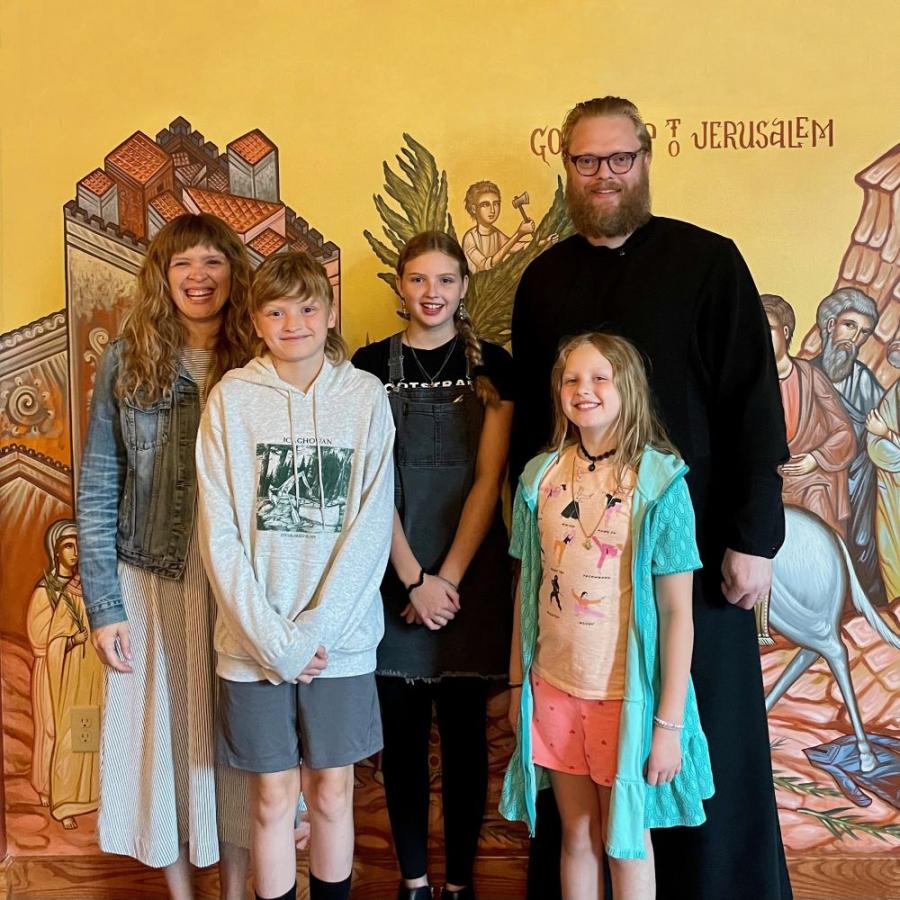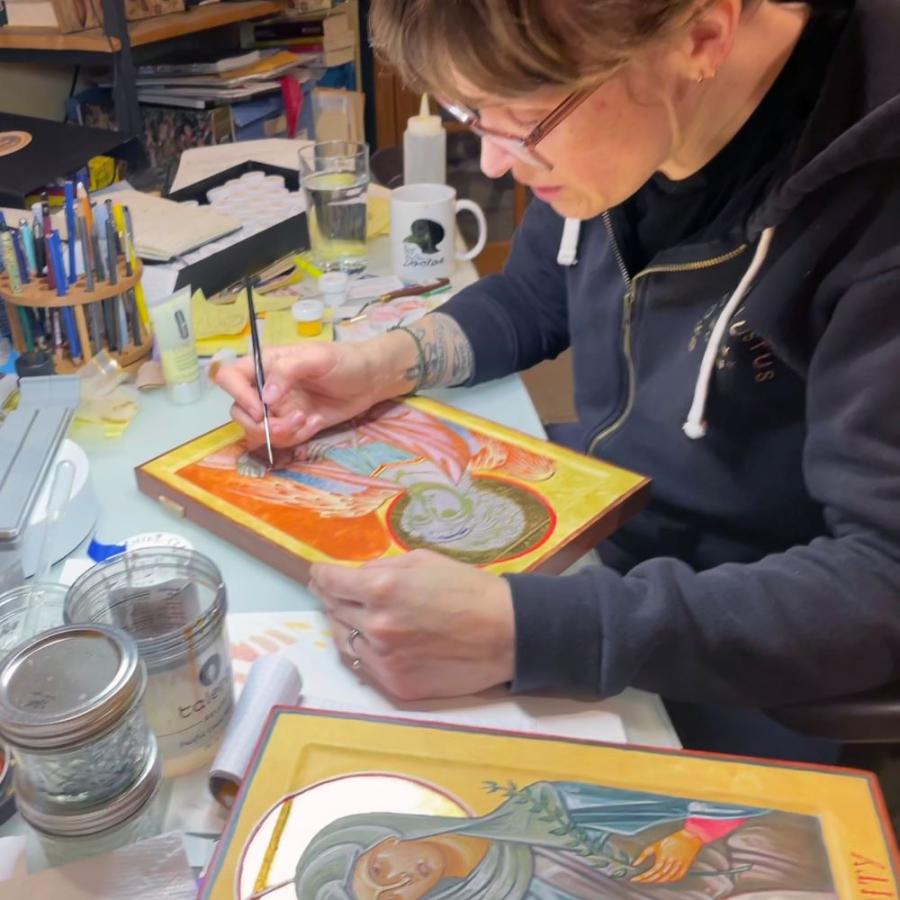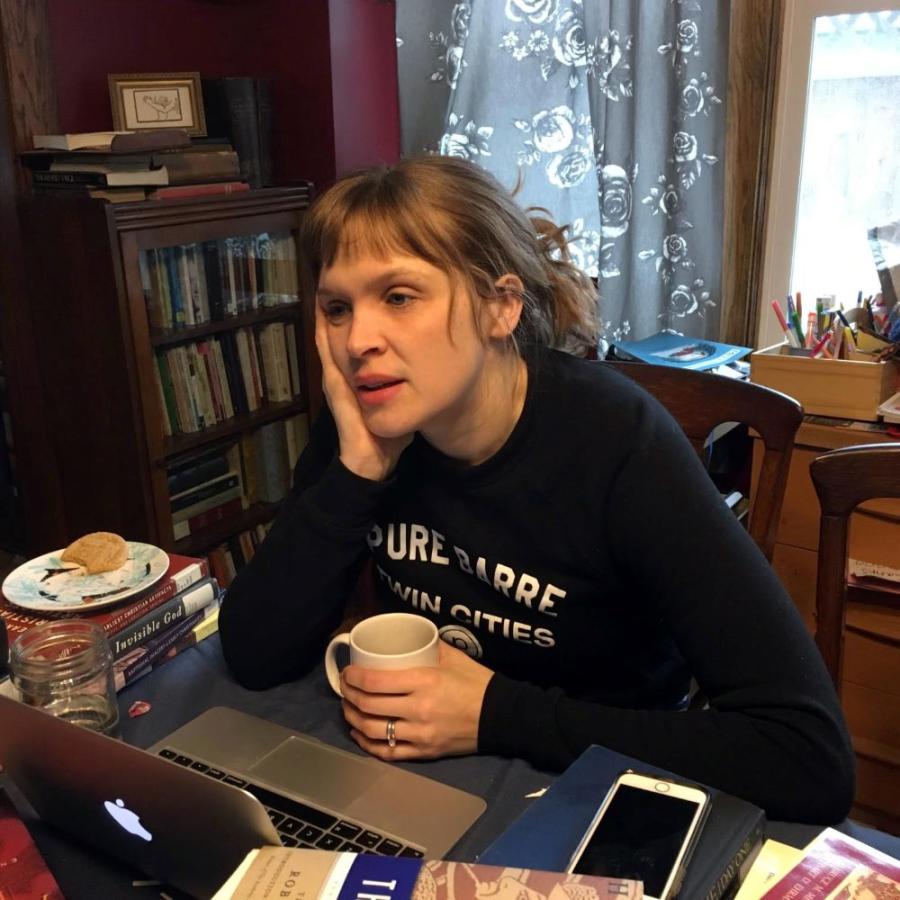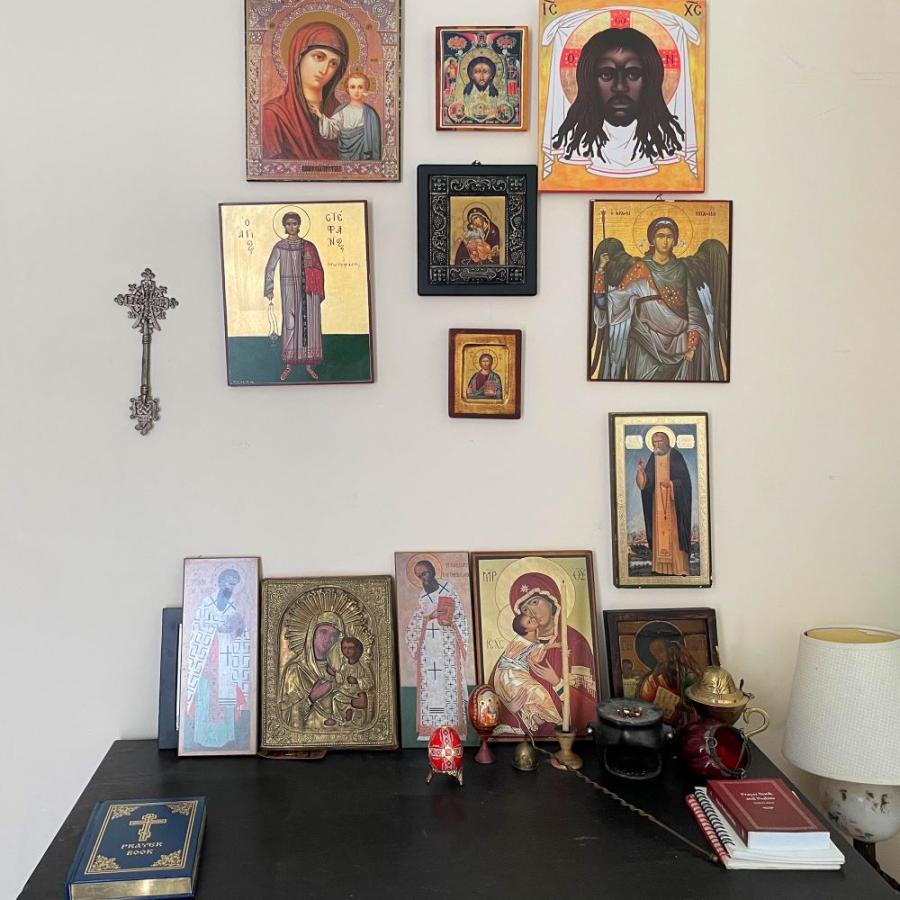
Jennifer Awes Freeman is our Woman of the Week, nominated for her work iatthe intersection of theology and the arts. You see her here with her family in their parish church. We asked her to tell you how she ended up in this line of work:
“Art came first for me. I've always identified as an artist, even as a child; drawing and painting were just how I processed things. I didn't grow up in a religious family, so I used the arts to meet that need. Through a friend, I encountered Christianity for the first time in middle school. I was asking angsty, “meaning of life” kinds of questions. I became part of a Baptist church in rural Wisconsin, and that's how I ended up going to Bethel College (now University) in the Twin Cities. I majored in studio art: painting and drawing.
“I went to a Christian college because I still didn't know much about Christianity and was interested in learning more about theology. I learned that Christianity was much more diverse than the Baptist version I had encountered. I learned more about historical Christianity even while working and taking art history classes. Eventually, I became involved in theater, switched majors, and graduated with a degree in technical theater with a minor in art history. I worked in technical theater in the Twin Cities for a few years after college. I did a semester’s worth of a post-baccalaureate program in studio art, illustrated a couple of children's books, and exhibited my paintings. I also began a phase of figuring out church stuff on my own. I went to different nondenominational churches that were emergent and more arts-focused, one of which had stations of the cross exhibits and things like that. I ended up in New York City working as the assistant tech director in a theater department. Since I was interested in more structured, supported academic study, and still had these big questions, I applied for a master's program in art history, but then learned about the Institute of Sacred Music at Yale Divinity, which I saw as a great opportunity to bring together the two things I was trying to understand.
“That's where I really got sucked into the past. I became inspired by medieval and Byzantine art. Previously, I had been interested in iconography for my own artmaking. I had thought of icons as the funny things that happen when people try to make images of God. But when I started taking classes in medieval theology, medieval Latin, and Byzantine art and traveled to Istanbul, I found myself slowly filling in some of the gaps. I also became increasingly liturgical in my Christian practice. It took about four years from the first time I attended an Orthodox liturgy to my being received. By then, it just made sense: this image-rich environment, and the most beautiful liturgy I'd ever encountered.
“Because I was able to deepen my art-making training and pair that with an academic and historical study of religious art at Yale, I became interested in the question of why and how we make images of God. I had a real identity crisis when I was applying for PhD programs. I asked myself: am I an art historian or a historical theologian? I feel like I am always trying to do both. Art is theology itself–it's not always just illustrating theological texts, and I think art does something distinct from written theology. I ended up doing my PhD at Vanderbilt University with Robin Jensen (who is now at the University of Notre Dame). Her approach was far more theologically engaged than most art historians that I encountered.
“After that, I had a postdoctoral fellowship with the Louisville Institute, where they placed you in a theological setting, usually a seminary or Divinity School. Because I was already living in the Twin Cities at that time, I requested to be put at a college. I was assigned to the theology department at the University of Saint Thomas and taught art and theology classes for a couple of years. I was then offered a position at the United Theological Seminary of the Twin Cities, where I am now. There are only a handful of programs in divinity schools and seminaries in the United States that explicitly focus on art and theology. It's unfortunate that these programs are so rare, because in lived religion art is ubiquitous, not just in the Orthodox church. All churches have a visual culture, a material culture.”
Axia!


Our Woman of the Week is Jennifer Awes Freeman, nominated for her work as a theologian and art historian. You see her here working on an icon of an archangel. We asked her to tell you what she wants people to know about how images can constitute theological resources.
“There are several ways. One, which may be the most obvious, is through iconography or through subject matter. Depictions of biblical stories or saints' lives or things like that are making theological claims or propositions. This can be for teaching, or for a spiritual model or edification. You know, illustrations are always interpreted by an artist, right? So even if it seems like a 1-to-1 correlation between image and text, there's an interpretation that's being filtered through the artist.
“Of course, the Orthodox perspective on icons is that it isn't just merely a teaching tool, although it can do that too if, for example, the priest references it in a sermon or something. But there's also a more spiritual opportunity for encounter, right? Or a way of focusing prayer and things like that.
“This is me speaking as an artist: art is theological in its very creation. It is spiritual for the person who's doing the creating. And that's less about the outcome or the final product. Icon painting is a great example of this: it is the opportunity for meditation and prayer, which all the different steps of creating the icon present. But I would say just as much that things like embroidery or cross stitch or cooking can be a great opportunity, all of these things can be made prayerful or a way to enjoy creating things with our hands. The materiality of art making could include something like dance as an embodied art form, right? So the very materiality also contributes theological meaning. Preparing a meal for a loved one can have a eucharistic kind of connotation. All these different art forms have a lot of really rich potential for theological reflection and interpretation,
“There’s a Turkish photographer who took a photograph re-imagining the image by Caravaggio of Doubting Thomas (which is not a distinctly Orthodox image at all). The photographer remakes the image, but it's all with women. The central figure is not being presented as a literal Jesus, but it's kind of recreating of that moment and has a very different feeling to it. It reimagines the image and I think it succeeds in a way. When artists revise or recreate an image, then of course, it directs you back to the original and then you find yourself reconsidering the original, right?
“A funny thing is that my own academic research is on early medieval Christianity in Europe, where I focus mostly on the Carolingians (the time of Charlemagne) in the eighth and ninth centuries. But part of my research has also been on the Western response to the iconoclastic controversy. So really, the primary way that I engage historical Orthodoxy in my research is through the Western response to it in some ways. In my current teaching position, I'm the only Orthodox person there at the institution. It's a very ecumenical and increasingly inter-religious student body. And so I incorporate Orthodox theology into the historical theology class, but it's a very small part of what I teach. Much of my professional life is in conversation with people who either are recovering from bad experiences with Christianity, or are not at all familiar with Orthodoxy.
“Students have a variety of responses to the images I show in class. I think an advantage I have as a medievalist is that I'm often showing them images that they haven't seen before. I like drawing on imagery that's influential, but maybe not as well known. For example, one would be the devotion to the side wound of Jesus in medieval Christianity, which has eucharistic significance. The side wound is understood to be like a birth canal and also like a nursing breast. Some of these ideas go back to Clement of Alexandria, who has a hymn where he talks about the milk of Jesus. There’s a medieval Bible, known as the Moralized Bible, which is basically a highly illustrated Bible that puts scenes from the Old Testament next to scenes from the New Testament and interprets them through each other. One of my favorite examples is an image of Eve being created out of the side of Adam, which is paired with the crucifixion, where the personification of the church or ecclesia is being born out of the side of Jesus on the cross.
“Students are surprised–I think they don't realize how much feminine theology or how much this idea of Jesus' mother was prevalent in medieval Christianity. This can hopefully help them appreciate historical theology as a resource in their contemporary context. Medieval women mystics are a big part of that too. One of my most popular classes is on women mystics, such as Julian of Norwich. We start with the big question: what does it mean to see God? We talk about some biblical precedents, but then start with the Desert Mothers and Fathers, and early monasticism, and then jump to the 10th and 11th centuries. Students who are unsure of their relationship to Christianity, but are interested in a relationship with the divine, find these women's writings to be compelling.”
Jennifer Awes Freeman is our Woman of the Week. As always, we asked her to tell you about her morning routine. She is also showing you her icon corner.
“I wake up around 6:30 AM. I'd like to say my routine begins with something pious like prayer, but really I get up early to get my kids to their two different bus schedules on time. That is the very first thing I do in the morning. Then, after I succeed in doing that, a cup of coffee for me. Usually I would start answering emails then, which is just a horrible way to start the day. But having just come back from a sabbatical and still facing some writing projects that are due very soon, I'm trying to write for 30 minutes in the morning before I get sucked into work emails, lecture preparation, or the things that can take up all the time in the world.


“One of the highlights of my sabbatical was taking a class with the Prosopon School of Iconography here in Minneapolis. That was the first time I painted an icon, and I just loved it. I had a wonderful experience and it was just incredible; it was both challenging and also very relaxing. I was so calm all week long, I didn't check any emails, and I just painted all day and tried to breathe very slowly so I could make good lines. As soon as the class ended, I wished I could start it again. It almost felt painful to not be painting after having painted so much for one week. And so, for my own Christmas present, I bought myself pigments and a board and have had them just sitting in my studio office for quite a while. And then just a little over a week ago, I finally got up the nerve to start a new icon all by myself for the first time. So there's another part of my aspirational morning practice: to do just a little bit of work on my icon each day. The danger is that I'll just get sucked into it and I won't stop painting and then I won't get my work done! But, you know, emails will always be with us.”
Thank you, Jennifer!


